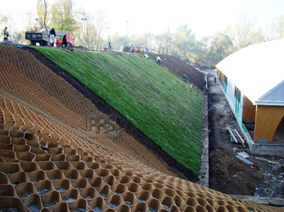With more and more of the world’s population living in cities – and another 2.5 billion people set to live in them by 2050 according to the UN – making the cities of the future more pleasant to live in despite potential overcrowding is one of the biggest challenges facing urban planners and developers.
One of the best ways to do so is by including room for green, natural spaces – areas where residents can escape the noise, pollution, hustle, and bustle of city life. Here we take a look at some of the many benefits of green spaces within the city limits, and how nature and technology can work together to make our cities healthier, happier, and more economically viable places.
Community and Recreation
Aside from making great venues for community events, parks and other green spaces encourage a healthier lifestyle, especially when combined with dedicated sports facilities such as basketball courts. They often become the hub of the local neighborhood, areas where parents and children can form connections and make new friends, or where local businesses can organize community events. They can even have a positive effect on crime rates, with more eyes out on the street and healthier activities for otherwise bored youths to pursue! The opening of the Bloomingdale Trail or ‘606’ elevated greenway in Chicago, for example, saw a decrease in crimes of all types along the route. And perhaps most notably, the decrease was largest in lower-income neighborhoods.
Greening the Asphalt Landscape with Vegetation
In urban environments, plants and technology can work especially well together to turn available engineered areas into aesthetically pleasing green slopes and walls.

A sustainable type of soil stabilization technology known as geocells is often used in the construction of roads, railways, and ports. Their unique honeycomb shape makes them ideal solutions for green slopes, embankments and retaining walls. Developed by PRS Geo-Technologies, the geocells create a mattress of cells for plants. These are like thousands of planters that protect the root system of young plants as they grow to create green, vegetated slopes or retaining walls. Aside from creating a much more visually pleasing urban landscape, the geocells also create a micro-ecosystem of plants, insects and other small creatures, with improved water drainage and soil quality. The same geocell system is utilized to reinforce urban road pavements – so they last longer with fewer repairs, as well as roadside drainage ditches and buried underground pipeline infrastructure.
Reducing the Urban Heat Island effect and improving air quality
Because cities are constructed largely from materials like concrete and asphalt which absorb heat throughout the day, cities are notably hotter than the surrounding countryside. This doesn’t just make them more uncomfortable to live and work in, it often goes hand in hand with higher electricity consumption, as more residents resort to air conditioning. The addition of green roofs, parks, and street trees is one of the easiest and most attractive ways to mitigate this effect – and comes with many additional benefits too. Trees, shrubs, and grasses help to remove dust, smoke and other harmful contaminants from the air, all while absorbing CO2 and providing oxygen and shade.
Improved stormwater management
Because green areas allow for water to sink into the ground rather than simply running off, they can be invaluable in areas prone to flooding during heavy rains. Soil and vegetation also help to filter and purify groundwater, removing pollutants and reducing pressure on drainage facilities and treatment plants down the line. By encouraging property owners to plant their own trees, Garland, Texas, managed to reduce average water runoff during a storm by a whopping 19 million cubic feet! This is an excellent example of what can be achieved through collaboration between government and private citizens.
Healthier residents
Providing green spaces encourages residents to get outdoors and increase their exercise levels, an invaluable tool in the modern age when so many of us lead very sedentary lifestyles. Outside of the school playground, parks and green spaces are often the only outdoor areas where children can play safely, especially for residents who live in apartment housing. There’s a noticeable effect on mental health and wellbeing too, as green spaces provide quiet areas for relaxation and encourage residents to get some much-needed sunlight, which can be effective in combating mild depression. Considering all of these benefits, the inclusion of natural spaces is one of the most affordable and rewarding ways to make our towns and cities healthier, more beautiful and more resilient.

